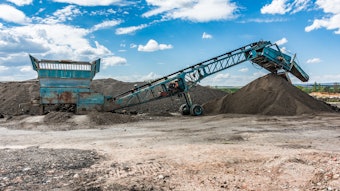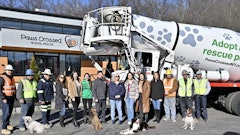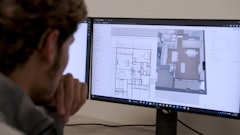
When Kevin Barkley with the city of Griffin, Georgia, received a call from Jimmy Hastings at the Caterpillar Griffin Engine Center asking for ideas on wood-waste recycling, Barkley knew he could help.
“We had already started a tree material recycling program at our landfill with Dell Walker of Enviro-Recyclers,” explains Kevin Barkley, Assistant Director of Solid Waste for the city of Griffin, Georgia. “So when Jimmy Hastings at the Caterpillar Griffin Engine Center called me to discuss recycling their wood-waste material, I was confident that we could provide a solution. We’d been working with Caterpillar on solid-waste disposal and with Dell Walker on tree material recycling, so it was really just a matter of coordinating and connecting the parties together.”
Building on an existing program
The three parties — Dell Walker with Enviro-Recyclers, Jimmy Hastings with Caterpillar and Kevin Barkley with the city of Griffin — met to discuss a plan to recycle pallets and other wood waste at the Caterpillar Griffin Engine Center.
“Engines and generators arrive at our facility on pallets, which are used as wooden shipping platforms,” details Jimmy Hastings, EHS Manager for the Caterpillar Griffin Engine Center in Griffin, Georgia.
Once engines are removed from their pallets, the pallets are reused until they are no longer viable, creating what many companies would consider waste wood destined for a landfill. Hastings viewed this wood as an opportunity and created a recycling program for it. The current process to recycle Griffin Engine Center’s pallets and additional wood waste works like this: Pallets and other recyclable wood are brought to an outside wood yard (located on-site at the Griffin Engine Center) to be made into wood chips. Dell Walker, President of Enviro-Recyclers, relies on a Morbark 4600 Wood Hog chipper, powered by a Cat® C27 ACERT™, to grind the pallets into chips.
About four times a year, Walker and his crew bring equipment to the Griffin Engine Center to process the pallets and wood material that has accumulated at the facility. The location is perfect for grinding as the site has a poured cement slab, which provides stability for the grinding equipment. The process generally takes about two weeks, and the end result is about 20 to 30 tractor-trailers of chipped wood.
“Our Morbark chipper can handle anything,” stresses Walker. “It will grind pallets and trees — almost anything you can throw in it (minus the metal). Our desired end result is a 3-inch or smaller wood product.”
The chipped wood is then trucked off-site to local companies wanting to purchase the material. One of those companies, Pratt Industries, utilizes the chipped wood in its gasification process of creating energy to produce cardboard material.
“One key is have good outlets for the material you want to recycle or dispose of,” notes Barkley. “We are fortunate that we have many good outlets for the material we’re recycling and the environmental programs we’re involved with. (See sidebar on “Keep Griffin Spalding Beautiful Inc.”)
“The amount of material we have is easy to handle and is appropriate for this size of community. We can also deliver the finished material to the end user, in most cases, within an hour away from the city of Griffin,” he adds.
Embracing sustainability
All three companies involved in this process are dedicated to recycling and sustainability.
Caterpillar — Caterpillar as a company has embraced sustainability for many years. Since 2005, Caterpillar has published an annual sustainability report, with detailed performance information and data and highlights about specific projects that support its sustainable development efforts. Each year the report serves as the flagship document for stakeholders to understand Caterpillar’s commitment to sustainability. The company also has a website dedicated to its sustainability efforts.
“When I arrived here four years ago, sustainability was already a process at the Caterpillar Griffin Engine Center,” says Hastings. “In these last four years, we have fine-tuned existing processes to a higher degree. Now recycling and sustainability are daily activities and a thought process for everyone employed here, from the shop floor to top management. Sustainability simply has a lot deeper definition today than it did even four years ago.”
The city of Griffin — The city of Griffin is a model for implementing, and maintaining, a recycling program. Griffin, Georgia, is the only city in Georgia that requires residential recycling. (See sidebar “City of Griffin — A glimpse at starting a recycling program from scratch.”)
“We do whatever we can to educate and promote recycling, best-use practices and answer questions people have when it comes to properly disposing of their waste or simply being environmentally friendly,” says Barkley.
The city of Griffin has won several awards from the Georgia Association of North America Solid Waste Association for best recycling programs in the city of Griffin for curbside and commercial recycling. Griffin has also received several awards from the Georgia Recycling Coalition for its recycling efforts including the mandatory recycling program it has implemented.
It has also been honored with national and statewide recognition for its “I Don’t Recycle” program, a recycling education program it put together with the Department of Community Affairs in Georgia.
Enviro-Recyclers — “I have been recycling since before it was ‘cool’ to recycle,” says Walker. His 10-year career began with developers and home builders — new rules and regulations in the county stopped them from burying or burning tree trash or wood waste.
“I was approached for a solution so I started grinding the wood into a fuel product. I marketed this product to large companies like paper mills and discovered they could burn this material for power. So we began grinding tree trash and wood waste, whether it’s pallets or other wood material, into mulch and producing a waste-to-energy product.
“It made sense to keep this material out of landfills,” he adds. “That has always been our goal.”
Resource management vs. waste management
“These pallets and wood material are marketable products at the end of the day,” stresses Hastings. “It all starts off as raw material; we process it and turn it into viable product [wood chips] that is in demand in our area.”
“We look at this as a revenue source for us,” confirms Barkley. “One of the best things about recycling, in addition to helping the environment, is that there’s not much overhead. There’s no disposal cost because we’re also in the hauling business. The material we pick up is also a product that somebody will pay us for. The revenue on both sides — hauling it for the customer and receiving revenue from the processed material — has really helped our bottom line on a tight budget.
“This business is really changing. It’s not the same old ‘pick up and throw it in the landfill’ kind of business anymore. We are looking at waste wood as resource management rather than waste management,” confirms Barkley.
The folks at Caterpillar and Enviro-Recyclers think along the same lines.
“It costs money to develop recycling programs,” says Hastings. “But at the same time, if you develop the programs and continue to refine them and reach outside to get the right people in place, then it becomes successful at the end of the day and it’s the right thing to do.”
“We’re definitely in the right business,” concludes Walker. “Not just the right business — we’re doing the right thing for the environment. The competition in this world is always going to be tough, but we feel we have an advantage because we have embraced sustainability. This is the way to go; there is no turning back.”





![Img 1707[56]](https://img.forconstructionpros.com/files/base/acbm/fcp/image/2023/04/IMG_1707_56_.6437076c97961.png?auto=format%2Ccompress&fit=crop&h=191&q=70&rect=0%2C462%2C1920%2C1080&w=340)












![Glp Porsche 072723 465 64ee42287c29e[1]](https://img.forconstructionpros.com/files/base/acbm/fcp/image/2024/03/GLP_PORSCHE_072723_465.64ee42287c29e_1_.65e88b8589b9c.png?auto=format%2Ccompress&fit=crop&h=135&q=70&rect=0%2C520%2C2250%2C1266&w=240)











